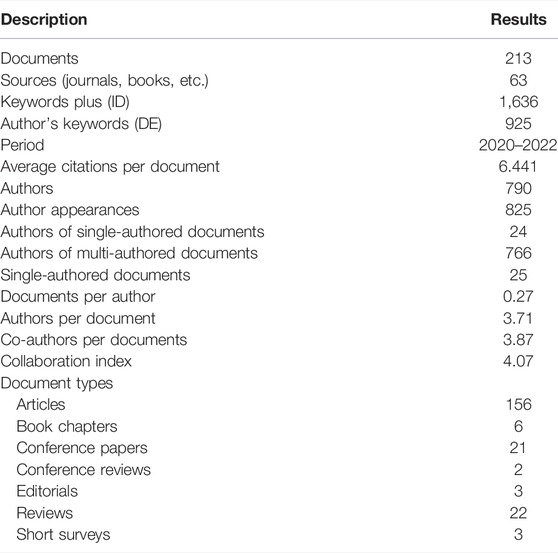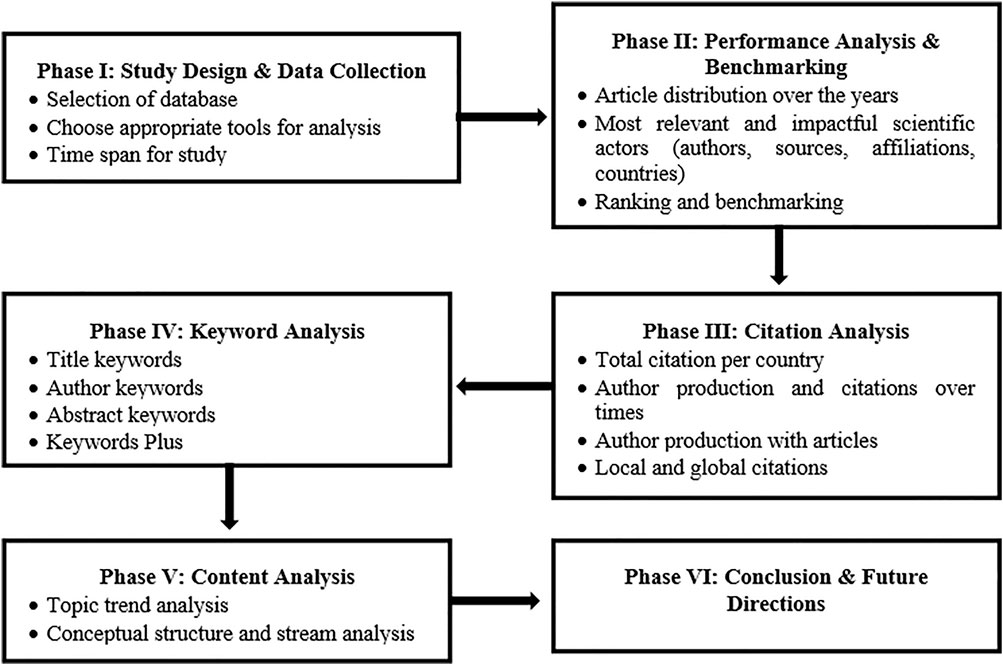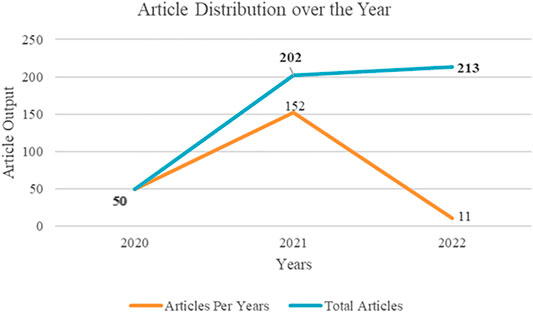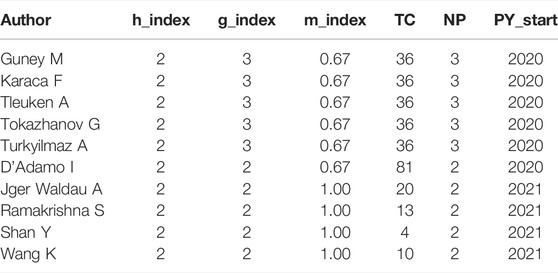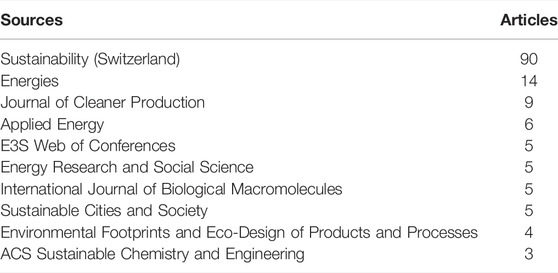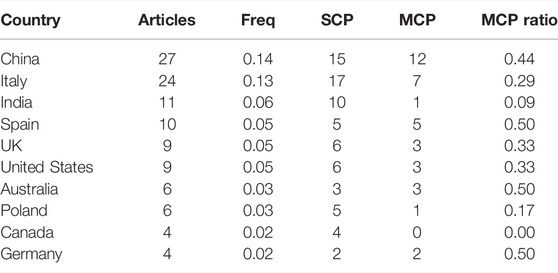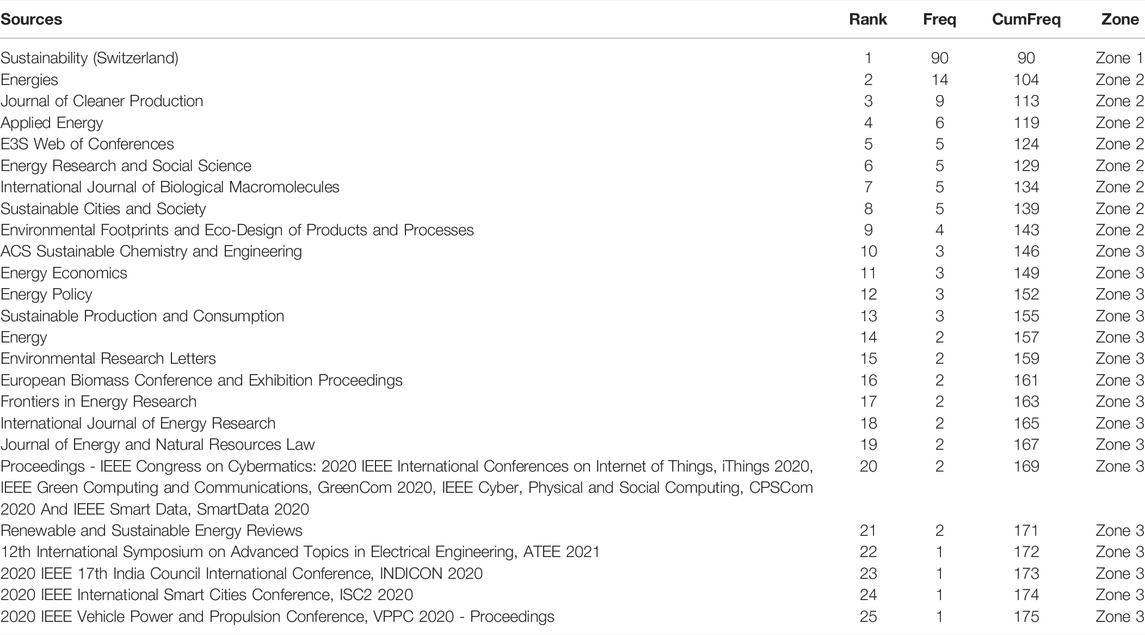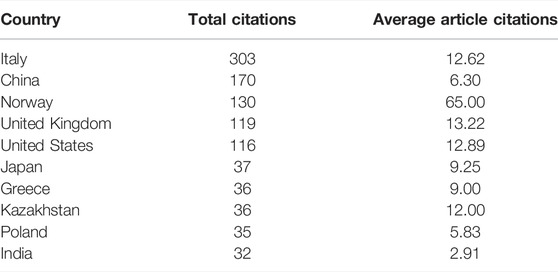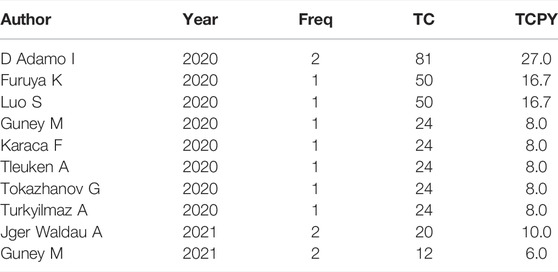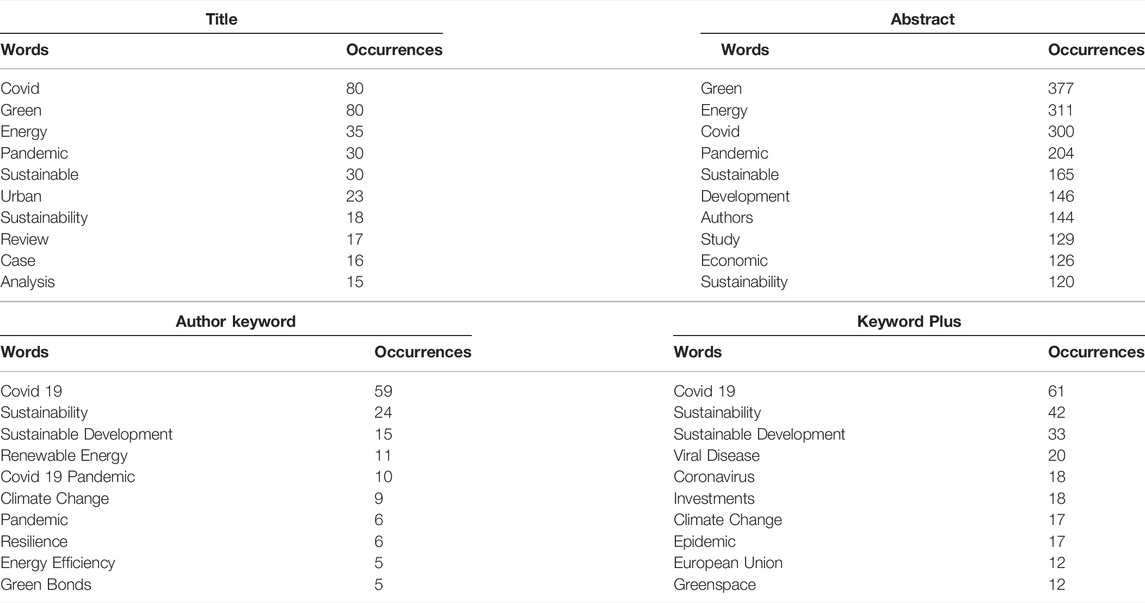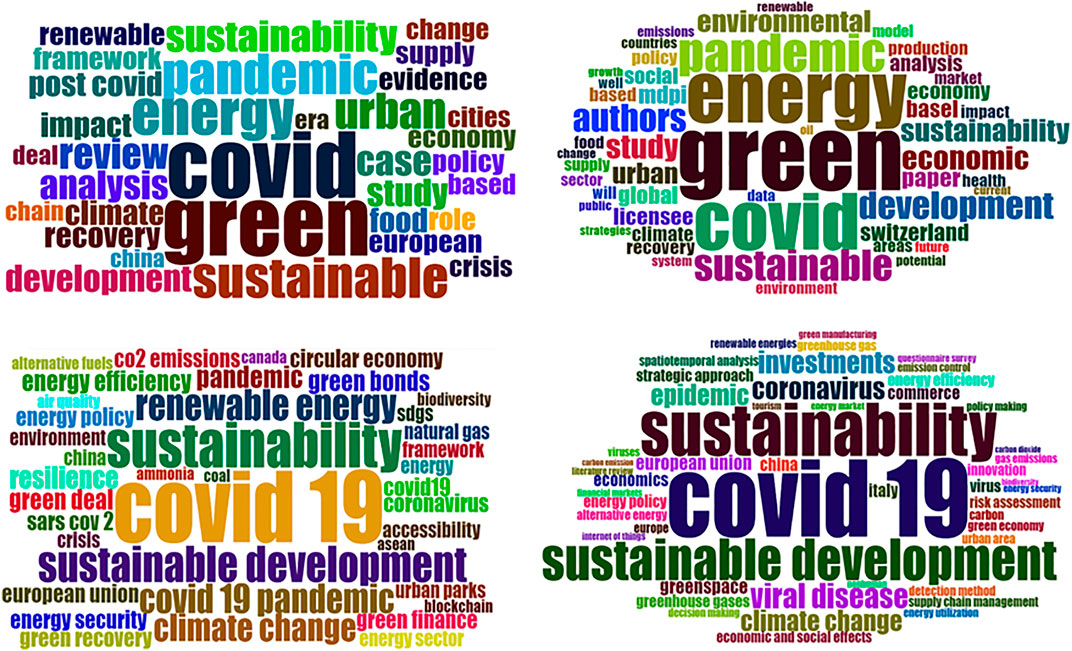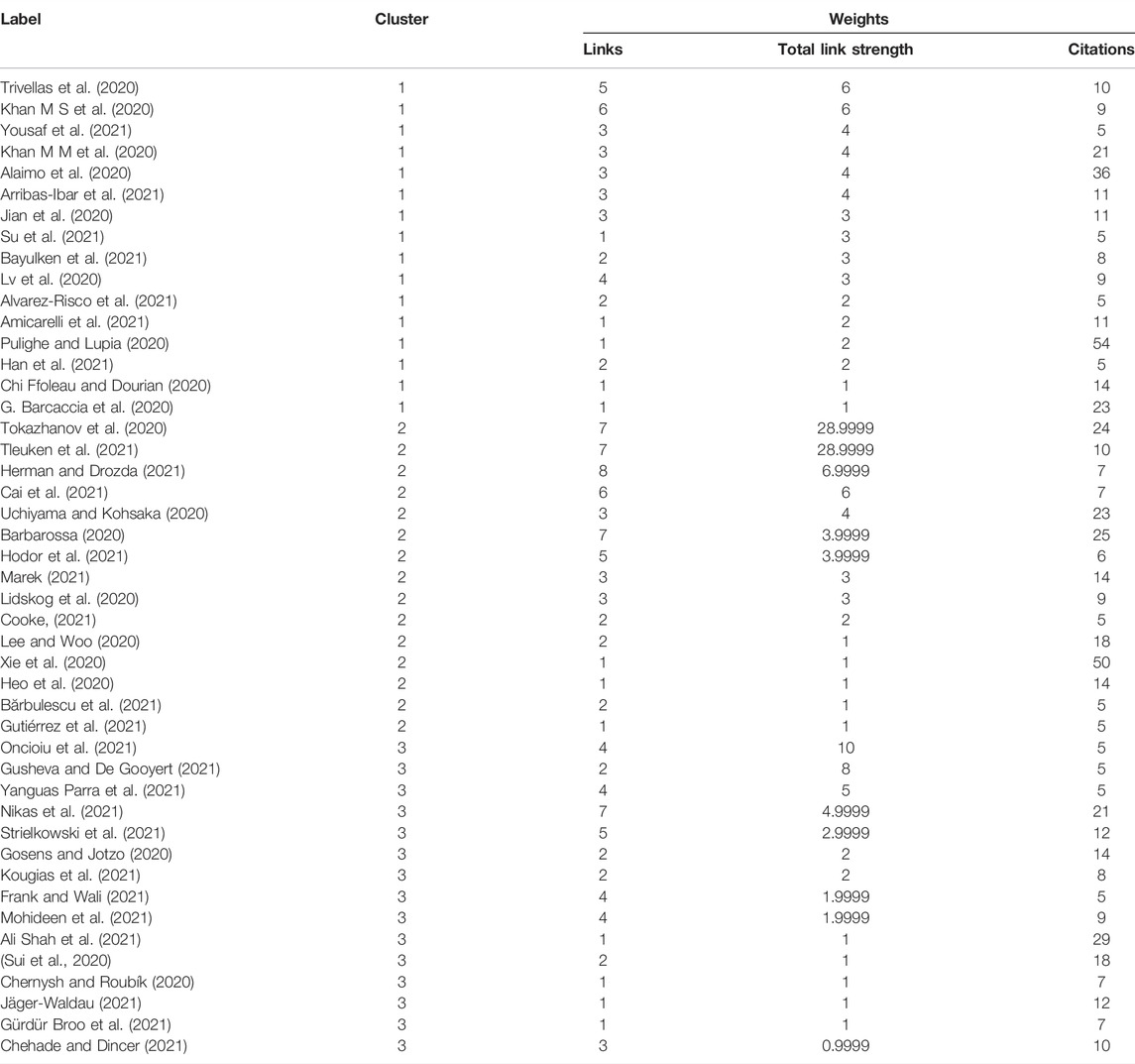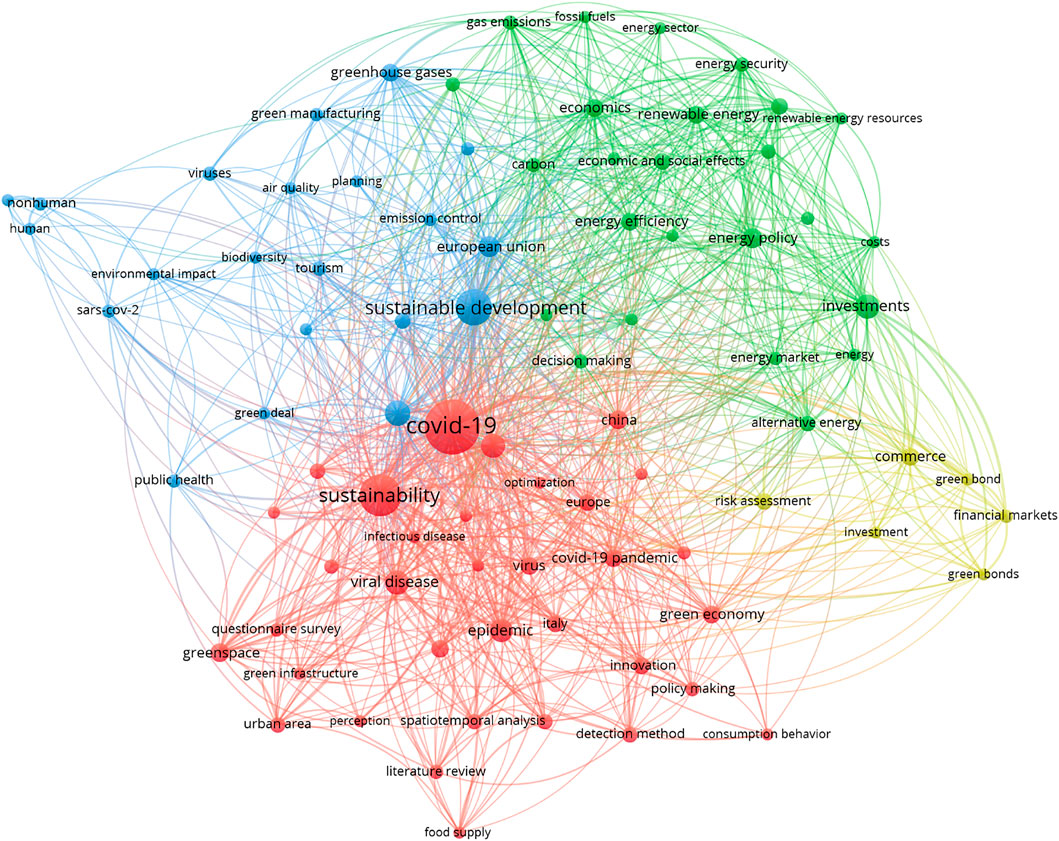Green Practices: A Solution for Environmental Deregulation and the Future of Energy Efficiency in the Post-COVID-19 Era
- 1Institute of Business and Management, University of Engineering and Technology, Lahore, Pakistan
- 2Lahore College for Women University, Lahore, Pakistan
- 3Institute of Quality and Technology Management, University of the Punjab, Lahore, Pakistan
The world has paid increasing attention to energy efficiency projects since the Paris agreement and UN climate summit. Recently, the COVID-19 pandemic accelerated the process of the green energy transition, which has attracted considerable attention from economists, environmentalists, and international organizations and has led to significant research in energy. This study addresses the importance of green energy practices in the post-COVID-19 era to deal with environmental deregulation using bibliometric analysis. Data were extracted from the Scopus database from 2020 to 2022. Results indicate that China gained a prominent place in publishing topic-related articles. However, Italy stands at the top position in total and average article citations. Sustainability is the most productive journal, followed by Energies and the Journal of Cleaner Production. Nazarbayev University and the University of Cambridge are the most contributing research institutes. In general, the cooperation of authors, institutes, and countries strengthens research; however, collaboration at the author level across the nation was lower than in others. The study highlights three research streams and four themes by systematically conducting a bibliometric coupling and co-occurrence network that anticipates and significantly segregates literature. Bibliometric coupling identifies three research streams of sustainable green business strategies, green infrastructure requirements, and green solutions and opportunities from COVID-19. Furthermore, the co-occurrence network proposes four main themes related to green innovation in the epidemic era, security and sustainable development goals with green practices, public health protection and green finance, and investment and risk management. The results provide insights into current research in the field of energy and will assist future work promoting environmentally friendly projects.
1 Introduction
The world faces severe environmental challenges due to continuously changing lifestyles and business methods (Suki et al., 2022). The process of industrialization and economic appraisal results primarily from environmental deregulation that highlights the need to improve current production practices (Tamazian et al., 2009). In this scenario, energy efficiency is becoming important an important issue in addition to environmental pressure and increasing greenhouse gas emissions. The current energy system mainly relies on fossil fuels that are harmful to human health, society, and the environment (Mohideen et al., 2021). However, steady progress is being made globally in terms of the energy transition. Even though low carbon systems are eco-friendly, organizations still do not adopt them due to high adoption costs (D’Adamo et al., 2020; K. I.; Khan, et al., 2021a). The government and policymakers emphasized implementing an environment-friendly energy system such as photovoltaic electricity generation, hydrogen, and fuel cell technologies after the outbreak of COVID-19 (Tian et al., 2022). However, some environment-related regulations have been relaxed during COVID-19 to boost the economy (Gautam et al., 2022), meaning there are mixed opinions available in the literature regarding the adoption of the green energy processes during the pandemic.
Some scholars consider this pandemic an opportunity to re-think new environmental regulations through a paradigm shift from traditional green energy, economic recovery, and global solidarity through environmental sustainability (Okoh, 2021). Economic activities have slowed down due to pandemic activities on the one hand, while on the other hand, due to lockdown, the suspension of industrial activities reduces carbon emissions and positively impacts the environment (K. I. Khan et al., 2022). In developed economies, governments simultaneously supported clean energy projects and economic revival plans. However, in developing countries, governments have to cut down the cost to financially support economic recovery schemes (Gautam et al., 2022). Therefore, antagonism has been observed between positive and negative discourse. This might provide reasons for scholars and practitioners to raise questions about the future of energy transitions. Academic literature on the topic is overwhelming, making it difficult for scholars and practitioners to have a constructive overview of the relevant information. This study conducts a bibliometric analysis to discuss the importance of adopting green energy practices in the post-COVID-19 era to deal with environmental deregulation. This topic is relatively emerging in terms of academic research but has received increasing attention during the outbreak of the COVID-19 pandemic. This increase is driven by the fact that the focus of academics and practitioners had changed, adopting more eco-friendly practices that lead to a continuously growing publication rate on the topic and make it difficult to obtain a comprehensive overview. This bibliometric analysis helps to answer the following research questions: 1) what are the most relevant and impactful scientific actors (authors, sources, affiliations, and countries) in the literature; 2) what are the future trends and research streams of the topic?
2 Methods
Bibliometrics analysis is an area of study that analyzes the bibliographic materials related to a particular topic of interest using quantitative methods (Nasir et al., 2021a). It is a widely used technique that summarizes the most significant contributions by key authors, journals, institutions, and countries in the field, which further highlights future areas of research for scholars (K. I. Khan, et al., 2021b). The current study conducted a bibliometric analysis on the importance of green energy practices adoption in the post-COVID-19 era to deal with environmental deregulation. Data were collected from the Scopus database for the post-COVID-19 era (1 January 2020, to 4 January 2022). We applied the query “TITLE-ABS-KEY (green AND (covid OR corona* OR sars* OR mers)) AND (LIMIT-TO (SUBJAREA, “ENER")) AND (LIMIT-TO (PUBYEAR, 2022) OR LIMIT-TO (PUBYEAR, 2020))” and limited it to the subject area of energy. We adopted the strict criteria of document inclusion and added only relevant literature that falls under the scope of the study. We deleted the Errata, duplicates, documentaries, and documents not written in English. Table 1 provides details about the documents used in the bibliometric analysis.
Table 1 shows that out of 213 documents, 156 are articles, 22 reviews, 21 conference papers, 6 book chapters, 3 editorials, 3 short surveys, and 2 are conference reviews. The average citation per document is 6.44, while the collaboration index is 4.07. We used ‘Biblioshiny’ within R language for bibliometric analysis such as descriptive, keywords, co-occurrence, citations, and various factorial analyses, including content analysis. VOS viewer is used for mapping the interactions of the significant research actors. We applied Microsoft Excel tools to cross-check the analysis and produce editable figures and tables. Although the interpretation of the results is merely descriptive, the current study has added insight into the topic and future directions for further studies. Figure 1 explains the detailed study design.
3 Results
This section discusses the detailed study results based on the information extracted from the relevant and reliable sources. The study conducted performance and benchmarking analysis to explain article production in the post-COVID-19 period, most contributing actors (authors, sources, affiliations, and countries), ranking, and benchmarking. It then conducts citation analysis to highlight the total citations per country, author production, and citations over time. It also includes keyword analysis to specify the most frequently searched keywords included in the title, abstract, keywords, and keywords plus.
3.1 Performance Analysis and Benchmarking
3.1.1 Article Distribution Over the Years
The number of articles published is considered an essential indicator to evaluate the development trend of research over the years. Figure 2 presents the number of articles published during the post-COVID-19 era. Fifty articles were published in 2020, whereas in 2021, the number increased to 152. Until 2022, the date of query, a total of 213 peer-reviewed articles were published. However, researchers expect this trend to grow over the years due to the increasing demand for green energy practice adoption (Suki et al., 2022).
3.1.2 Most Relevant Scientific Actors (Authors, Sources, Affiliations, and Countries)
The first five authors in the list of top-ranked authors have the same h, g, and m index values (h-index = 2; g-index = 3; and m-index = 0.67). Their total citations are TC = 36, and net production per article is NP = 3, and all articles were published in 2020 (see Table 2). These scholars highlighted the issue of designing comfortable and eco-friendly living spaces during the COVID-19 pandemic. Their findings stated that health and safety, comfort, and environment are the major aspects to consider in designing residential buildings (Tokazhanov et al., 2020). Later, Tokazhanov et al. (2021) sought an opinion from the stakeholders (academia, industry, and medical experts) on the previously identified indicators (health and safety, comfort, and environment) and found health and safety as the most crucial aspect among them. Their evaluating determinants for health and safety category are better building air quality, tenants’ mental health, and prevention of virus propagation (Tokazhanov et al., 2021). Their study further elaborates that new designs must be equipped with modern touchless technology tools and a proper sanitation system, and greener spaces should be developed to improve mental health conditions without harming the environment (Tokazhanov et al., 2020). They also emphasized implementing green building certification systems (GBCSs) in the era of a virus outbreak (Tleuken et al., 2021). These authors also assessed the readiness of existing residential housing for the identified indicators of GBCSs dealing with pandemic-resilient requirements.
D’Adamo has the highest total citations (TC = 81) but ranked second among the most contributing authors in the field. D’Adamo and Rosa (2020) believe that climate change is the result of a deterioration in eco-friendly practices. There is a need to recognize the role of the green economy to avoid social and economic disasters in the future. The existing resources should be deployed efficiently to fulfill infrastructural needs and ensure energy efficiency. In this regard, D’Adamo et al. (2020), proposed integrating residential photovoltaic plants with the application of energy produced and self-consumed to develop a decentralized system. Photovoltaic energy is considered substantial for transitioning from fossil to a green society due to its cost reduction feature. The Italian Government also supported this policy, particularly during the COVID-19 period. They also provided an economic assessment of a 3 kW plant that creates an opportunity to handle environmental deregulations and generate a source of revenue for the consumer.
Jger Waldau stands at the third position with TC = 20; NP = 2. Jäger-Waldau (2021) is also a supporter of photovoltaic electricity generation and provided evidence of it becoming the fastest-growing power generation worldwide. This system is cost effective and plays an essential role in renewable electricity and energy efficiency (Kougias et al., 2021). Mohideen et al. (2021) emphasized the use of a low-carbon energy system that requires a transition from fossil fuel to hydrogen and fuel cell technologies. Fossil fuels contribute to massive greenhouse gas emissions, which affect human health, society, and the environment. However, the cost of a low-carbon energy system is high (Manganelli et al., 2021). The COVID-19 situation has prompted governments and policymakers to re-think future investment in eco-friendly energy areas in alignment with the sustainable development goals framework of the United Nations. Shan has focused on the air pollution caused by the transportation sector. COVID-19 affected the transportation sector, reducing energy demand CO2 emission (Schulte-Fischedick et al., 2021). Cai et al. (2021) discussed improving customer satisfaction regarding tourist accommodation during the pandemic period.
Table 3 depicts the most contributing literature sources relevant to the topic. ‘Sustainability’ remains the most impactful source in the field by publishing 90 research articles related to green energy, environmental concerns, renewable energy, energy and resources policy, sustainable development, carbon emission, climate change, and green practices. The second influential source of publication is ‘Energies,’ which publishes 14 articles and addresses the issue of climate scenarios, economic recovery, renewable energy, risk management, wind power, energy efficiency, energy policy, energy security, energy sustainability, renewable energy, energy consumption, transition pathways, and energy transition. The third most prominent source of publication is ‘Journal of Cleaner Production’ with nine publications. All the publications discussed the issue of energy efficiency in the context of COVID-19.
Table 4 shows the country-wise and institutional affiliation-wise distribution of publications. China is the most contributing country that published 71 articles on the topic. The second most influential country is Italy which published 62 articles. The UK and the United States stand at the third position with 36 publications. The other contributing countries in terms of publications are Spain (31), India (24), Poland (18), France (15), Australia (13), and Germany (12). Table 4 also sheds light on the top-ranked institutions that published the relevant material related to green practices and energy efficiency. The Nazarbayev University of Kazakhstan has a top position in the list with eight publications. Two universities in the UK are included in the list: the University of Cambridge (8) and the University College London (4). In the third position, two universities are placed with five publications, whereas in the fourth position and fifth place, four and two universities stand with four and three publications, respectively.
Table 5 provides information about the corresponding authors’ countries. China again stands at the top for the correspondence of 27 articles, having SCP = 15; MCP = 12; and MCP ratio = 0.44. Italy ranked at the top based on SCP (intra-country collaboration), while the MCP ratio (inter-country collaboration) of Spain, Australia, and Germany is the highest (0.50). The total articles published in Italy are 24; its MCP = 7; and the MCP ratio is 0.29. India is involved in the correspondence of 11 publications, whereas Canada and Germany have originated four articles.
3.1.3 Ranking and Benchmarking
The total documents extracted from the Scopus database are 213, including articles (156), book chapters (6), conference papers (21), conference reviews (2), editorials (3), reviews (22), and short surveys (3). We assess the productivity of publications from one zone to another through Bradford’s law (Nasir et al., 2021b). Table 6 shows that only one journal ‘Sustainability’ falls in zone 1, which is considered Bradford’s zone of the core journal, with 90 publications. Zone 2 contains eight documents that have a total of 53 citations. The most prominent sources in the second quantum are ‘Energies’ (14) and ‘Journal of Cleaner Production’ (9). The bottom zone included 16 sources with 32 citations and was cited at least one time from 2020 to 2022.
Table 7 presents the source impact to highlight the core journals related to the topic under study from the field of energies. The information about the top ten sources is arranged based on indexes (h, g, and m), total citation (TC), net production (NP), and publishing year (PY start). Table 7 shows that the most prominent source of publication is ‘Sustainability (Switzerland)’ that has indexes (h-index = 12; g-index = 20; m-index = 4.00; TC = = 588; NP = 90) in 2020. ‘Journal of Cleaner Production’ stands at second position based on indexes (h-index = 5; g-index = 9; m-index = 1.67) in 2020. However, its total citations (TC = 127) are less than ‘Environmental Research Letters’ (TC = 128), and similar is the case with its net production (NP = 9), which is less than the net production (NP = 14) of the ‘Energies’. The ‘Applied Energy’ ranked at third position with h-index = 3; g-index = 6; m-index = 1) in 2020. Its total citations are 69, and net production is 6.
3.2 Citation Analysis
Citation analysis represents the most cited documents for the country and authors’ output during the sample period (Nasir et al., 2021a). It also differentiates the documents concerning local and global and local citation. Table 8 provided the country-wise total citation (TC) and average article citation (AAC) information. Results show that Italy ranked at the top in terms of total citation (TC = 303), whereas Norway attained the top position in terms of average article citation (AAC = 65). China and Norway placed at the second and third positions (TC = 170; TC = 130), respectively, in terms of total citation. The United Kingdom got the second (AAC = 13.22) and the United States got the third position (AAC = 12.89) in the average article citation. India got at the last position in terms of total citations (TC = 32) and average article citations (AAC = 2.91).
Table 9 explains the author’s production and citations over time. D’ Adamo seems to be the most prominent researcher in the field of energy. He published two articles in 2020 with 81 citations, whereas his total citations per year are 27. Other than D’ Adamo, Jger Waldau and Guney have also published two articles with TC = 20; TCPY = 10, and TC = 12; TCPY = 6, respectively, in 2021. Furuya and Luo ranked second with TC = 50; TCPY = 16.7, while all the remaining five authors (Guney, Karaca, Tleuken, Tleuken, and Turkyilmaz) have attained third place in 2020 with one publication (TC = 24; TCPY = 8).
Table 10 explains the local and global citations of the articles with their publication details. Venter et al. (2020) have the highest local and global citations (LCs = 7; GCs = 125) for the article published in 2020. Their research focused on the impact of social distancing during the COVID-19 period on recreational activities. Results indicate that the outdoor recreational activities in green spaces have increased during the pandemic, indirectly mitigating the virus’s spread. Furthermore, their findings highlight the importance of green open spaces in urban planning for attaining the goal of sustainable cities in the future (Venter et al., 2020). Xie et al. (2020) have the second-highest local citations, i.e., five, whereas their global citations are 50, the third-highest citations relevant to the topic. Their research discussed the impact of quarantine and social distancing policies on the mental and physical health of the people. The respondents emphasized the need for social interactions and fulfilled their needs by visiting the nearby parks, which helped them cope with the adverse health conditions. Their findings highlight the importance of urban parks, open recreational areas, and a green urban building environment in maintaining a healthy quality of life that fulfills the social interaction needs of the residents even during a pandemic period.
Table 10 reported that Hosseini (2020) has the second-highest global citations, i.e., 86, and the third-largest local citation, i.e., four, among the top ten articles. His study explained the direct and indirect consequences of COVID-19 on the transition of green and low-carbon energy adoption. He believed that the current pandemic scenario slows down the economic activities that ultimately impact the process of green energy adoption. The government should restructure its green policies and involve the private sector to effectively implement energy renewal and green efficiency strategies (Hosseini, 2020). Uchiyama and Kohsaka (2020) assessed the effect of socio-economic and environmental attributes of the urban residential areas on the access to a green environment. The visit to green places (parks, gardens, and agricultural lands) is essential for the planning, health, social justice, and equity of the residents, avoiding viruses in the future (Uchiyama and Kohsaka, 2020). Lee and Woo (2020) explored the impact of the newly announced post-COVID-19 energy-efficient strategy by the Korean Government to build a low-carbon and environment-friendly economic system. All these actions are taken to promote green energy practices that reduce the usage of traditional energy resources and help in the transition process.
Tleuken et al. (2021) emphasized the green building certification system in the post-pandemic era to facilitate a healthy environment in the urban areas. Gosens and Jotzo (2020) discussed the Chinese new deal policy anticipated to support the green energy transition in the post-COVID-19 era. However, the policy has emphasized more investment in fossil fuel industries than in renewable energy projects. They believe that COVID-19 may reduce the Chinese ambition to implement green energy plans, so they must reconsider it to avoid future disasters (Gosens and Jotzo, 2020). Tokazhanov et al. (2020) emphasized the comfortable and eco-friendly residential buildings to promote a healthy environment during viral disease spread. Sui et al. (2020) provided evidence about understanding the emission patterns of buses and cars during a pandemic period and emphasized taking better investment decisions to promote an environment-friendly public transport system in the future. Barcaccia et al. (2020) discussed the impact of COVID-19 on food and agri-based businesses and emphasized research and development activities to promote these businesses.
3.3 Keyword Analysis
Keyword analysis reports the most repeated and frequently used essential concepts in the main body of an article from a specific field during the period under study. Table 11 highlights the top ten most significant concepts, words, and phrases used in the green energy literature during the post-COVID-19 era in the field of energy. These keywords are primarily used in the titles, abstracts, authors’ keywords, and keyword plus. Their comparison analysis confirms the existence of similarities in the most employed words in the body of the article. For example, ‘Covid 19,’ ‘Green,’ ‘Energy,’ ‘Sustainability,’ ‘Development,’ ‘Pandemic,’ and ‘Sustainable’ are the frequently used words in all categories of keyword analysis.
Another important point presented in Table 11 is that the concept of green energy is not limited to the field of energy but is also related to the diversified fields of social sciences such as economics, finance, and environmental sciences. For example, keywords such as ‘Investments’ and ‘Green Bonds’ are more relevant to the field of finance. At the same time, ‘Development,’ ‘Urban,’ ‘Economic,’ ‘Sustainability,’ and ‘European Union’ are more related to the discipline of economics. On the other hand, the keywords ‘Climate Change,’ ‘Renewable Energy,’ ‘Greenspace,’ and ‘Energy Efficiency’ are mainly discussed in the environmental sciences field.
Some generic terms are used in the title and abstract keywords that represent the research terminologies such as ‘Analysis,’ ‘Study,’ ‘Review,’ and ‘Case.’ Figures 3.1–3.4 depict the most important words used in the article. These words/concepts/phrases were identified through word cloud analysis, where their size reflects the importance of the word. In Figure 3.1, the five most essential words are COVID-19, green, energy, sustainability, and development. In Figure 3.2, the most popular phrases are energy, green, sustainable, COVID, and development. Figure 3.3 includes COVID-19, sustainable development, renewable energy, and climate change, whereas investment, COVID-19, sustainability, viral disease, and climate change are the most prominent words found in Figure 3.4. Interestingly, China is the major country found in the title and author keywords, while Switzerland has existed in abstract keywords and Italy is identified in keyword plus analysis.
4 Conceptual Framework
In addition to the main influential aspects, the conceptual framework to identify core themes and research streams in the relevant topic may provide critical implications and future research directions. Therefore, we adopt the strategy (Khan et al., 2021a) that uses the bibliometric coupling and co-occurrence network to identify key research streams and themes.
4.1 Bibliometric Coupling
Bibliometric coupling occurs when two articles cite the same references (Kessler, 1963). Figure 8 shows the bibliometric coupling of the green energy practices literature. We used a VOS viewer to conduct analysis and found three clusters separated by blue, green, and red colors. The bubble size is dependent on the relative link strength of the document label with other labels. Figure 8 highlights three clusters representing contemporary themes, and details of these themes are provided in Table 12.
Figure 4 shows three main clusters of green practices, energy efficiency, and environmental deregulations. These clusters represent various research streams based on bibliometric coupling among articles, explained in Table 12. The strength of a relationship is measured by links, total link strength, and citations. The main research stream of cluster 1 (red) is the sustainable green business, supply chain, and food security strategies in a pandemic. The main findings of the cluster are sustainable supply chain management and food safety in COVID-19 (Trivellas et al., 2020; Su et al., 2021; Chi Ffoleau and Dourian, 2020). Furthermore, the research stream provided details about food security (Khan M M et al., 2020; Pulighe and Lupia, 2020) and innovative sustainable ecosystems (Arribas-Ibar et al., 2021). Cluster 2 (green) possesses highly linked articles, and the main research stream is defined as the post-COVID-19 environment and strategies for green infrastructure management. The cluster explains the green infrastructure dynamics in social distancing during COVID-19 (Herman and Drozda, 2021), green practices and infrastructural requirements during pandemic (Tokazhanov et al., 2020; Tleuken et al., 2021), and innovative policies for sustainable transitions during COVID-19 (Lee and Woo, 2020).
The third cluster is constructed on fifteen research articles. The main research stream is about green solutions, recovery, and opportunities from the COVID-19 pandemic. The highly linked article is written by Oncioiu et al. (2021), who saw COVID-19 not as a threat but as an opportunity for sustainability and the development of green practices. Furthermore, cluster 3 provides relevant literature regarding green recovery strategy during pandemics (Gusheva and De Gooyert, 2021; Ali Shah et al., 2021), efficient management of energy consumption (Strielkowski et al., 2021), and environmental protection (Frank and Wali, 2021; Chernysh and Roubík, 2020).
4.2 Co-Occurrence Network
A co-occurrence network provides rigorous analysis to find thematic patterns in the literature using the link strength of the most significant keywords. The study uses a VOS viewer to conduct the co-occurrence analysis and provided details of keywords in Table 13 with identified cluster and recommended theme. The co-occurrence network is divided into four dynamic clusters (red, green, blue, and yellow) with a significant underlying study theme, presented in Figure 5.
The keyword segregation, cluster information, and recommended themes related to Figure 5 are provided in Table 13. The red cluster in Figure 5 represents the theme of sustainable, innovative, and strategic green policy in the epidemic era. The stated theme provides a detailed explanation of green strategies and environmental quality (Magazzino et al., 2021), sustainable and innovative ecosystem (Arribas-Ibar et al., 2021), post-COVID-19 sustainable growth (Bărbulescu et al., 2021), and transitions towards green strategies (Lee and Woo, 2020).
Energy security and sustainable development goals for social and economic development are the themes for the co-occurrence network’s second cluster (green). The theme highlights the green business and objectives to harmonize sustainable development goals (Yousaf et al., 2021; Russo et al., 2021; Filatova et al., 2021) and impact, challenges, and opportunities for renewable energy production and efficiency (Gansukh, 2021; Celik et al., 2021; El Moummy et al., 2021; Wang et al., 2021). Green practices and public health protection represent the thematic foundations for the third cluster (green). It possesses the literature on sustainable development, climate change, and public health policies (Reinwald et al., 2021; Bayulken et al., 2021; Klioutchnikov et al., 2021; Sifa et al., 2021; Cole, 2020; Lyytimäki et al., 2020). The fourth theme provides direction toward financial markets and deals with green finance and investment strategies. The literature provides risk assessment strategies and control with the help of green financial instruments (Chakrabarti and Sen, 2021; Fu and Ng, 2021).
5 Conclusion
Green energy has become a topic of interest for scholars and policymakers in the recent pandemic era. The world is paying more attention to adopting green practices to deal with environmental challenges. However, the transition process is slow due to a lack of investment in eco-friendly energy projects. The government is trying to involve the private sector in green energy projects such as photovoltaic electricity generation, hydrogen, and fuel cell technologies after the outbreak of COVID-19. However, it requires lots of effort and finances in the implementation process. The academicians are also working in the same line to create awareness and signify energy efficiency’s importance. The literature on the topic is overwhelming, and it is difficult for the researchers to build a constructive view. That is why the current study conducted a bibliometric analysis to give a comprehensive view of the topic.
The study examined the significance of green energy efficiency in the post-COVID-19 era to deal with environmental deregulation. Data were extracted from the Scopus database (2020–2022) in energy, and almost 73% of the included documents were articles. China is the most influential country at the global level, followed by Italy, the UK, and the United States, which significantly contributed to the literature. However, in terms of citations, Italy gained a prominent place. At an institutional level, Nazarbayev University is the most contributing institution that the University of Cambridge, the National Research Centre, and the Sapienza University of Rome follow. Finally, sustainability is a top-ranked journal, where almost 58% of articles related to the topic were published. Conversely, the collaboration between the authors, countries, and institutions has increased over time.
The study provides research streams and themes with the help of bibliometric coupling and co-occurrence networks. The research streams provide direction in the specific research area, and research themes provide segmentations of what has been done. The study found three research streams; the first research stream directs the literature towards sustainable green business, supply chain, and food security strategies in a pandemic. The second research stream represents the post-COVID-19 environment and strategies for green infrastructure management. The third research stream is related to green infrastructure dynamics in social distancing during COVID-19. The study highlights the four highly contributing research themes. The first research theme provides sustainable, innovative, and strategic green policies in the epidemic era. The second research theme is energy security and sustainable development goals for social and economic development. The third theme is related to green practices and public health protection, and green finance, investment, and risk management are included under the fourth theme.
6 Post-COVID-19 Opportunities for Energy Efficiency
The COVID-19 pandemic has drastically changed the world’s focus on green energy adoption. Although, the government, international, and local organizations have become more active in environmental issues after the Paris climate agreement and the UN Summit. However, the transition process was slow. The COVID-19 pandemic has provided a great opportunity to re-think, re-establish, and re-enforce the new energy policy towards low carbon emission, green efficiency, and renewable energy projects. In many economies, the projects of photovoltaic electricity generation, hydrogen, and fuel cell are either developmental or implementational. So, there is a need to develop a regulatory framework to promote and implement such projects. Green energy projects require a considerable amount of funding. Therefore, there is a need to involve the private sector in such projects. Governments should motivate the financial sector to promote green finance, green credit, green bonds, and other eco-friendly financial instruments to support a green economy. Subsidies and tax exemptions could be offered to eco-friendly energy projects. Furthermore, financial support should be provided to the research and development activities to explore innovative and cheap energy renewal methods that enhance energy efficiency.
7 Limitations of This Study
This study also faces some limitations that are essential to address to enhance the scope of the study. First, the data were extracted from the Scopus database. Even though it is a reliable source, the researchers still believe that future scholars can use the combinations of databases such as Scopus and Web of Sciences to get a more comprehensive view of the topic. Second, the study is based on quantitative data, which cannot access the quality or content of the publications. That is why few of the publications included in the analysis did not directly address the energy efficiency topic. Instead, they mainly address the topic of environmental deregulation and climate change. Third, the analysis is conducted at one point in time the results of the search query may change over time.
Data Availability Statement
The raw data supporting the conclusions of this article will be made available by the authors, without undue reservation.
Author Contributions
KK performed conceptualization, designed the research, and completed the write-up of influential aspects. AN provided data analysis and conceptual framework. Conceptualization, editing, curation, and investigation were carried out by TR.
Conflict of Interest
The authors declare that the research was conducted in the absence of any commercial or financial relationships that could be construed as a potential conflict of interest.
Publisher’s Note
All claims expressed in this article are solely those of the authors and do not necessarily represent those of their affiliated organizations, or those of the publisher, the editors, and the reviewers. Any product that may be evaluated in this article, or claim that may be made by its manufacturer, is not guaranteed, or endorsed by the publisher.
References
Alaimo, L. S., Fiore, M., and Galati, A. (2020). How the COVID-19 Pandemic Is Changing Online Food Shopping Human Behaviour in Italy. Sustainability 12 (22), 1–18. doi:10.3390/su12229594
Ali Shah, S. A., Longsheng, C., Solangi, Y. A., Ahmad, M., and Ali, S. (2021). Energy Trilemma Based Prioritization of Waste-To-Energy Technologies: Implications for post-COVID-19 green Economic Recovery in Pakistan. J. Clean. Prod. 284, 124729. doi:10.1016/j.jclepro.2020.124729
Alvarez-Risco, A., Mlodzianowska, S., García-Ibarra, V., Rosen, M. A., and Del-Aguila-Arcentales, S. (2021). Factors Affecting green Entrepreneurship Intentions in Business university Students in Covid-19 Pandemic Times: Case of ecuador. Sustainability 13 (11), 6447. doi:10.3390/su13116447
Amicarelli, V., Tricase, C., Spada, A., and Bux, C. (2021). Households' Food Waste Behavior at Local Scale: A Cluster Analysis after the COVID-19 Lockdown. Sustainability 13 (6), 3283. doi:10.3390/su13063283
Arribas-Ibar, M., Nylund, P., and Brem, A. (2021). The Risk of Dissolution of Sustainable Innovation Ecosystems in Times of Crisis: The Electric Vehicle during the Covid-19 Pandemic. Sustainability 13 (3), 1–14. doi:10.3390/su13031319
Barbarossa, L. (2020). The post Pandemic City: Challenges and Opportunities for a Non-motorized Urban Environment. An Overview of Italian Cases. Sustainability 12 (17), 7172. doi:10.3390/su12177172
Bărbulescu, O., Tecău, A. S., Munteanu, D., and Constantin, C. P. (2021). Innovation of Startups, the Key to Unlocking post-crisis Sustainable Growth in Romanian Entrepreneurial Ecosystem. Sustainability 13 (2), 1–16. doi:10.3390/su13020671
Barcaccia, G., D’Agostino, V., Zotti, A., and Cozzi, B. (2020). Impact of the SARS-CoV-2 on the Italian Agri-Food Sector: An Analysis of the Quarter of Pandemic Lockdown and Clues for a Socio-Economic and Territorial Restart. Sustainability 12 (14), 5651. doi:10.3390/su12145651
Bayulken, B., Huisingh, D., and Fisher, P. M. J. (2021). How Are Nature Based Solutions Helping in the Greening of Cities in the Context of Crises Such as Climate Change and Pandemics? A Comprehensive Review. J. Clean. Prod. 288, 125569. doi:10.1016/j.jclepro.2020.125569
Cai, G., Hong, Y., Xu, L., Gao, W., Wang, K., and Chi, X. (2021). An Evaluation of Green Ryokans through a Tourism Accommodation Survey and Customer-Satisfaction-Related CASBEE-IPA after COVID-19 Pandemic. Sustainability 13 (1), 1–24. doi:10.3390/su13010145
Celik, D., Meral, M. E., and Waseem, M. (2021). “Restrictions and Driving Forces for Renewable Energy Production Development and Electrical Energy Demand in General and during COVID-19,” in 12th International Symposium on Advanced Topics in Electrical Engineering (Bucharest, Romania: ATEE). doi:10.1109/ATEE52255.2021.9425216
Chakrabarti, G., and Sen, C. (2021). Dynamic Market Risk of green Stocks across Regions: Where Does the Devil Lie? J. Clean. Prod. 303, 127028. doi:10.1016/j.jclepro.2021.127028
Chehade, G., and Dincer, I. (2021). Progress in green Ammonia Production as Potential Carbon-free Fuel. Fuel 299, 120845. doi:10.1016/j.fuel.2021.120845
Chernysh, Y., and Roubík, H. (2020). International Collaboration in the Field of Environmental protection: Trend Analysis and Covid-19 Implications. Sustainability 12 (24), 1–18. doi:10.3390/su122410384
Chiffoleau, Y., and Dourian, T. (2020). Sustainable Food Supply Chains: Is Shortening the Answer? a Literature Review for a Research and Innovation Agenda. Sustainability 12 (23), 1–21. doi:10.3390/su12239831
Cole, R. J. (2020). Navigating Climate Change: Rethinking the Role of Buildings. Sustainability 12 (22), 1–25. doi:10.3390/su12229527
Cooke, P. (2021). After the Contagion. Ghost City Centres: Closed “Smart” or Open Greener? Sustainability 13 (6), 3071. doi:10.3390/su13063071
D'Adamo, I., Gastaldi, M., and Morone, P. (2020). The post COVID-19 green Recovery in Practice: Assessing the Profitability of a Policy Proposal on Residential Photovoltaic Plants. Energy Policy 147, 111910. doi:10.1016/j.enpol.2020.111910
D’Adamo, I., and Rosa, P. (2020). How Do You See Infrastructure? Green Energy to Provide Economic Growth after COVID-19. Sustainability 12 (11), 4738. doi:10.3390/su12114738
El Moummy, C., Salmi, Y., Baddih, H., and Abouchabaka J, O. O. S. K. (2021). “The Role of Renewable Energy Sector in Reducing Unemployment: The Moroccan Case,” in E3S Web of Conferences. Editor S. Bourekkadi (Les Ulis, France: EDP Sciences), 234, 00101. doi:10.1051/e3sconf/202123400101
Filatova, I., Nikolaichuk, L., Zakaev, D., and Ilin, I. (2021). Public-private Partnership as a Tool of Sustainable Development in the Oil-Refining Sector: Russian Case. Sustainability 13 (9), 5153. doi:10.3390/su13095153
Frank, L. D., and Wali, B. (2021). Treating Two Pandemics for the price of One: Chronic and Infectious Disease Impacts of the Built and Natural Environment. Sustain. Cities Soc. 73, 103089. doi:10.1016/j.scs.2021.103089
Fu, J., and Ng, A. W. (2021). Scaling up Renewable Energy Assets: Issuing green Bond via Structured Public-Private Collaboration for Managing Risk in an Emerging Economy. Energies 14 (11), 3076. doi:10.3390/en14113076
Gansukh, Z. (2021). Mongol Dream beyond Fossil Fuels: Prosperity of Greenification. Renew. Energ. 171, 95–102. doi:10.1016/j.renene.2021.02.079
Gautam, P., Salunke, D., and Lokandwala, S. (2022). “Environmental Policies and Strategies for COVID-19,” in COVID-19 in the Environment (Elsevier), 297–308. doi:10.1016/b978-0-323-90272-4.00011-7
Gosens, J., and Jotzo, F. (2020). China's post-COVID-19 Stimulus: No Green New Deal in Sight. Environ. Innovation Societal Transitions 36, 250–254. doi:10.1016/j.eist.2020.07.004
Gürdür Broo, D., Lamb, K., Ehwi, R. J., Pärn, E., Koronaki, A., Makri, C., et al. (2021). Built Environment of Britain in 2040: Scenarios and Strategies. Sustain. Cities Soc. 65, 102645. doi:10.1016/j.scs.2020.102645
Gusheva, E., and De Gooyert, V. (2021). Can We Have Our Cake and Eat it? A Review of the Debate on green Recovery from the COVID-19 Crisis. Sustainability 13 (2), 1–16. doi:10.3390/su13020874
Han, L., Zhao, J., and Gu, Z. (2021). Assessing Air Quality Changes in Heavily Polluted Cities during the COVID-19 Pandemic: A Case Study in Xi'an, China. Sustain. Cities Soc. 70, 102934. doi:10.1016/j.scs.2021.102934
Heo, S., Lim, C. C., and Bell, M. L. (2020). Relationships between Local green Space and Human Mobility Patterns during COVID-19 for Maryland and California, USA. Sustainability 12 (22), 9401–9416. doi:10.3390/su12229401
Herman, K., and Drozda, Ł. (2021). Green Infrastructure in the Time of Social Distancing: Urban Policy and the Tactical Pandemic Urbanism. Sustainability 13 (4), 1–24. doi:10.3390/su13041632
Hodor, K., Przybylak, Ł., Kuśmierski, J., and Wilkosz-Mamcarczyk, M. (2021). Identification and Analysis of Problems in Selected European Historic Gardens during the Covid-19 Pandemic. Sustainability 13 (3), 1–18. doi:10.3390/su13031332
Hosseini, S. E. (2020). An Outlook on the Global Development of Renewable and Sustainable Energy at the Time of COVID-19. Energ. Res. andSoc. Sci. 68, 101633. doi:10.1016/j.erss.2020.101633
Jäger-Waldau, A. (2021). Snapshot of Photovoltaics − March 2021. EPJ Photovolt. 12, 2. doi:10.1051/epjpv/2021002
Jian, Y., Yu, I. Y., Yang, M. X., and Zeng, K. J. (2020). The Impacts of Fear and Uncertainty of Covid-19 on Environmental Concerns, Brand Trust, and Behavioral Intentions toward green Hotels. Sustainability 12 (20), 1–14. doi:10.3390/su12208688
Kessler, M. M. (1963). Bibliographic Coupling between Scientific Papers. Amer. Doc. 14 (1), 10–25. doi:10.1002/ASI.5090140103
Khan, K. I., Babar, Z., Sharif, S., Iqbal, S., and Khan, M. I. (2021a). Going green Investigating the Role of GSCM Practices on Firm Financial and Environmental Performance through green Innovation. Ijpm 14 (6), 681–701. doi:10.1504/ijpm.2021.117894
Khan, K. I., Mata, M. N., Martins, J. M., Nasir, A., Dantas, R. M., Correia, A. B., et al. (2022). Impediments of Green Finance Adoption System: Linking Economy and Environment. Emerg. Sci. J. 6 (2), 217–237. doi:10.28991/ESJ-2022-06-02-02
Khan, K. I., Nasir, A., and Saleem, S. (2021b). Bibliometric Analysis of Post Covid-19 Management Strategies and Policies in Hospitality and Tourism. Front. Psychol. 12, 5182. doi:10.3389/FPSYG.2021.769760
Khan, M. M., Akram, M. T., Janke, R., Qadri, R. W. K., Al-Sadi, A. M., and Farooque, A. A. (2020). Urban Horticulture for Food Secure Cities through and beyond Covid-19. Sustainability 12 (22), 1–21. doi:10.3390/su12229592
Khan, M. S., Saengon, P., Alganad, A. M. N., Chongcharoen, D., and Farrukh, M. (2020). Consumer green Behaviour: An Approach towards Environmental Sustainability. Sustain. Develop. 28 (5), 1168–1180. doi:10.1002/sd.2066
Klioutchnikov, I., Kliuchnikov, O., and Abouchabaka J, O. O. S. K. (2021). “Green Finance: Pandemic and Climate Change,” in E3S Web of Conferences. Editor S. Bourekkadi (Les Ulis, France: EDP Sciences), 234, 00042. doi:10.1051/e3sconf/202123400042
Kougias, I., Taylor, N., Kakoulaki, G., and Jäger-Waldau, A. (2021). The Role of Photovoltaics for the European Green Deal and the Recovery Plan. Renew. Sustain. Energ. Rev. 144, 111017. doi:10.1016/j.rser.2021.111017
Lee, J.-H., and Woo, J. (2020). Green New deal Policy of south korea: Policy Innovation for a Sustainability Transition. Sustainability 12 (23), 1–17. doi:10.3390/su122310191
Lidskog, R., Elander, I., and Standring, A. (2020). COVID-19, the Climate, and Transformative Change: Comparing the Social Anatomies of Crises and Their Regulatory Responses. Sustainability 12 (16), 6337. doi:10.3390/SU12166337
Lv, J., Wang, Z., Huang, Y., Wang, T., and Wang, Y. (2020). How Can E-Commerce Businesses Implement Discount Strategies through Social media? Sustainability 12 (18), 7459. doi:10.3390/SU12187459
Lyytimäki, J., Kangas, H.-L., Mervaala, E., and Vikström, S. (2020). Muted by a Crisis? Covid-19 and the Long-Term Evolution of Climate Change Newspaper Coverage. Sustainability 12 (20), 1–15. doi:10.3390/su12208575
Magazzino, C., Alola, A. A., and Schneider, N. (2021). The Trilemma of Innovation, Logistics Performance, and Environmental Quality in 25 topmost Logistics Countries: A Quantile Regression Evidence. J. Clean. Prod. 322, 129050. doi:10.1016/j.jclepro.2021.129050
Manganelli, M., Soldati, A., Martirano, L., and Ramakrishna, S. (2021). “Strategies for Improving the Sustainability of Data Centers via Energy Mix, Energy Conservation, and Circular Energy,” in Sustainability (Basel, Switzerland: Multidisciplinary Digital Publishing Institute), 13, 6114. doi:10.3390/su13116114
Mohideen, M. M., Ramakrishna, S., Prabu, S., and Liu, Y. (2021). Advancing green Energy Solution with the Impetus of COVID-19 Pandemic. J. Energ. Chem. 59, 688–705. doi:10.1016/j.jechem.2020.12.005
Nasir, A., Shaukat, K., Iqbal Khan, K., A. Hameed, I., Alam, T., and Luo, S. (2021b). Trends and Directions of Financial Technology (Fintech) in Society and Environment: A Bibliometric Study, Appl. Sci. 11, 10353. doi:10.3390/app112110353
Nasir, A., Shaukat, K., Khan, K. I., Hameed, I. A., Alam, T. M., and Luo, S. (2021a). What Is Core and what Future Holds for Blockchain Technologies and Cryptocurrencies: A Bibliometric Analysis. IEEE Access 9, 989–1004. doi:10.1109/ACCESS.2020.3046931
Nikas, A., Gambhir, A., Trutnevyte, E., Koasidis, K., Lund, H., Thellufsen, J. Z., et al. (2021). Perspective of Comprehensive and Comprehensible Multi-Model Energy and Climate Science in Europe. Energy 215, 119153. doi:10.1016/j.energy.2020.119153
Okoh, A. S. (2021). “Green Economic Recovery in Post-COVID-19 Era,” in Oil Mortality in Post-Fossil Fuel Era Nigeria (Cham: Springer), 187–203. doi:10.1007/978-3-030-60785-2_8
Oncioiu, I., Duca, I., Postole, M. A., Georgescu, G. C., Gherghina, R., and Grecu, R.-A. (2021). Transforming the Covid-19 Threat into an Opportunity: The Pandemic as a Stage to the Sustainable Economy. Sustainability 13 (4), 1–19. doi:10.3390/su13042088
Pulighe, G., and Lupia, F. (2020). Food First: COVID-19 Outbreak and Cities Lockdown a Booster for a Wider Vision on Urban Agriculture. Sustainability 12 (12), 5012. doi:10.3390/su12125012
Reinwald, F., Haluza, D., Pitha, U., and Stangl, R. (2021). Urban Green Infrastructure and Green Open Spaces: An Issue of Social Fairness in Times of COVID-19 Crisis. Sustainability 13 (19), 10606. doi:10.3390/su131910606
Rivero Gutiérrez, L., De Vicente Oliva, M. A., and Romero-Ania, A. (2021). Managing Sustainable Urban Public Transport Systems: An AHP Multicriteria Decision Model. Sustainability 13 (9), 4614. doi:10.3390/su13094614
Russo, F., Calabrò, T., Iiritano, G., Pellicanò, D. S., Petrungaro, G., and Trecozzi, M. R. (2021). Green and Safety School Regional Program to Sustainable Development Using Limited Traffic Zone. Ijsdp 16 (1), 71–79. doi:10.18280/ijsdp.160107
Schulte-Fischedick, M., Shan, Y., and Hubacek, K. (2021). Implications of COVID-19 Lockdowns on Surface Passenger Mobility and Related CO2 Emission Changes in Europe. Appl. Energ. 300, 117396. doi:10.1016/j.apenergy.2021.117396
Sifa, S. F., Sultana, R., and Bodrud-Doza, M. (2021). Climate Change and COVID-19: Crisis within Crises for Eradication of Poverty in Bangladesh. Environ. Footprints Eco-Design Prod. Process. 169, 169–188. doi:10.1007/978-981-16-3860-2_7
Strielkowski, W., Firsova, I., Lukashenko, I., Raudeliūnienė, J., and Tvaronavičienė, M. (2021). Effective Management of Energy Consumption during the COVID-19 Pandemic: The Role of ICT Solutions. Energies 14 (4), 893. doi:10.3390/en14040893
Su, Z., Zhang, M., and Wu, W. (2021). Visualizing Sustainable Supply Chain Management: A Systematic Scientometric Review. Sustainability 13 (8), 4409. doi:10.3390/su13084409
Sui, Y., Zhang, H., Shang, W., Sun, R., Wang, C., Ji, J., et al. (2020). Mining Urban Sustainable Performance: Spatio-Temporal Emission Potential Changes of Urban Transit Buses in post-COVID-19 Future. Appl. Energ. 280, 115966. doi:10.1016/j.apenergy.2020.115966
Suki, N. M., Suki, N. M., Sharif, A., Afshan, S., and Jermsittiparsert, K. (2022). The Role of Technology Innovation and Renewable Energy in Reducing Environmental Degradation in Malaysia: A Step towards Sustainable Environment. Renew. Energ. 182, 245–253. doi:10.1016/j.renene.2021.10.007
Tamazian, A., Chousa, J. P., and Vadlamannati, K. C. (2009). Does Higher Economic and Financial Development lead to Environmental Degradation: Evidence from BRIC Countries. Energy Policy 37 (1), 246–253. doi:10.1016/j.enpol.2008.08.025
Tian, J., Yu, L., Xue, R., Zhuang, S., and Shan, Y. (2022). Global Low-Carbon Energy Transition in the post-COVID-19 Era. Appl. Energ. 307, 118205. doi:10.1016/j.apenergy.2021.118205
Tleuken, A., Tokazhanov, G., Guney, M., Turkyilmaz, A., and Karaca, F. (2021). Readiness Assessment of green Building Certification Systems for Residential Buildings during Pandemics. Sustainability 13 (2), 1–31. doi:10.3390/su13020460
Tokazhanov, G., Tleuken, A., Durdyev, S., Otesh, N., Guney, M., Turkyilmaz, A., et al. (2021). Stakeholder Based Weights of New Sustainability Indicators Providing Pandemic Resilience for Residential Buildings. Sustain. Cities Soc. 75, 103300. doi:10.1016/j.scs.2021.103300
Tokazhanov, G., Tleuken, A., Guney, M., Turkyilmaz, A., and Karaca, F. (2020). How Is COVID-19 Experience Transforming Sustainability Requirements of Residential Buildings? A Review. Sustainability 12 (20), 1–20. doi:10.3390/su12208732
Trivellas, P., Malindretos, G., and Reklitis, P. (2020). Implications of green Logistics Management on Sustainable Business and Supply Chain Performance: Evidence from a Survey in the Greek Agri-Food Sector. Sustainability 12 (24), 10515–10529. doi:10.3390/su122410515
Uchiyama, Y., and Kohsaka, R. (2020). Access and Use of Green Areas during the COVID-19 Pandemic: Green Infrastructure Management in the "New Normal". Sustainability 12 (23), 9842–9849. doi:10.3390/su12239842
Venter, Z. S., Barton, D. N., Gundersen, V., Figari, H., and Nowell, M. (2020). Urban Nature in a Time of Crisis: Recreational Use of green Space Increases during the COVID-19 Outbreak in Oslo, Norway. Environ. Res. Lett. 15 (10), 104075. doi:10.1088/1748-9326/abb396
Wang, W., Moreno-Casas, V., and Huerta de Soto, J. (2021). A Free-Market Environmentalist Transition toward Renewable Energy: The Cases of germany, denmark, and the united kingdom. Energies 14 (15), 4659. doi:10.3390/en14154659
Więckowski, M. (2021). Will the Consequences of Covid-19 Trigger a Redefining of the Role of Transport in the Development of Sustainable Tourism? Sustainability 13 (4), 1–15. doi:10.3390/su13041887
Xie, J., Luo, S., Furuya, K., and Sun, D. (2020). Urban parks as green Buffers during the COVID-19 Pandemic. Sustainability 12 (17), 6751. doi:10.3390/SU12176751
Yanguas Parra, P., Hauenstein, C., and Oei, P.-Y. (2021). The death valley of Coal - Modelling COVID-19 Recovery Scenarios for Steam Coal Markets. Appl. Energ. 288, 116564. doi:10.1016/j.apenergy.2021.116564
Keywords: green practices, environmental deregulation, energy efficiency, green economy, COVID-19
Citation: Khan KI, Nasir A and Rashid T (2022) Green Practices: A Solution for Environmental Deregulation and the Future of Energy Efficiency in the Post-COVID-19 Era. Front. Energy Res. 10:878670. doi: 10.3389/fenrg.2022.878670
Received: 18 February 2022; Accepted: 28 March 2022;
Published: 29 April 2022.
Edited by:
Feng Sheng Chien, Fuzhou University of International Studies and Trade, ChinaReviewed by:
Idiano D'Adamo, Sapienza University of Rome, ItalyRuihui Pu, Srinakharinwirot University, Thailand
Copyright © 2022 Khan, Nasir and Rashid. This is an open-access article distributed under the terms of the Creative Commons Attribution License (CC BY). The use, distribution or reproduction in other forums is permitted, provided the original author(s) and the copyright owner(s) are credited and that the original publication in this journal is cited, in accordance with accepted academic practice. No use, distribution or reproduction is permitted which does not comply with these terms.
*Correspondence: Adeel Nasir, adeel.nasir@lcwu.edu.pk
 Kanwal I. Khan
Kanwal I. Khan Adeel Nasir
Adeel Nasir Tayyiba Rashid
Tayyiba Rashid